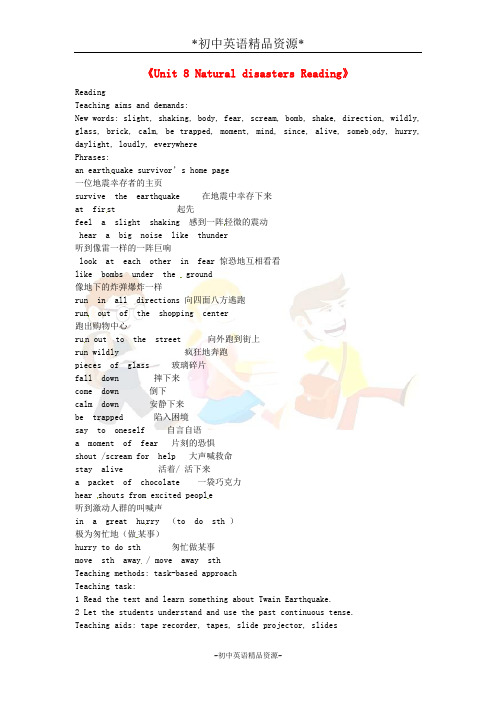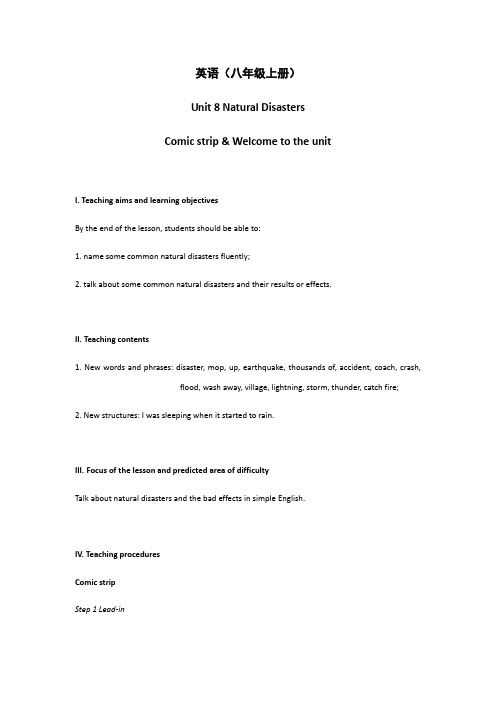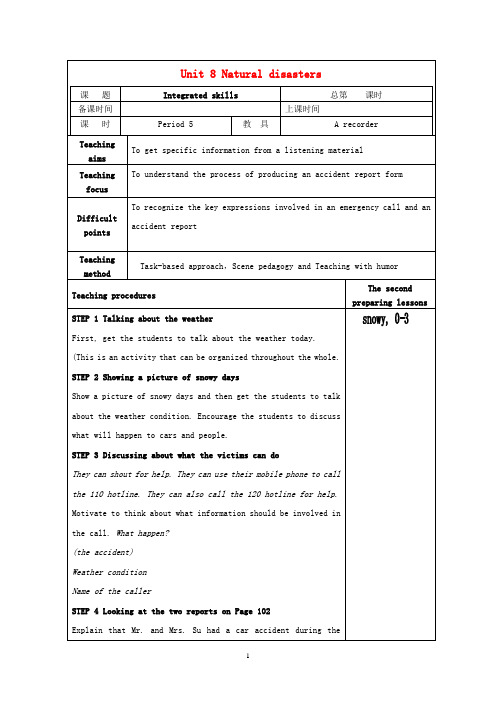【牛津译林版】2016八年级英语上册表格式教案:Unit 8 Natural disasters Study skills
- 格式:doc
- 大小:37.00 KB
- 文档页数:2

牛津译林版英语八上Unit 8《Natural》(task)说课稿一. 教材分析牛津译林版英语八上Unit 8《Natural》是一篇关于环境保护的文章。
文章通过讲述大自然的美丽和人类对大自然破坏的故事,引导学生关注环境保护,提高环保意识。
本节课的主要内容是让学生理解文章的主旨,掌握相关的词汇和语法知识,提高阅读理解和口语表达能力。
二. 学情分析学生在学习本节课之前,已经掌握了相关的词汇和语法知识,具备一定的阅读理解和口语表达能力。
但部分学生对环境保护的重要性认识不足,需要老师在教学中进行引导。
此外,学生对英语学习兴趣不高,需要老师通过丰富的教学手段激发学生的学习兴趣。
三. 说教学目标1.知识目标:让学生掌握文章中的关键词汇和语法知识,理解文章的主旨。
2.能力目标:提高学生的阅读理解和口语表达能力,培养学生的环保意识。
3.情感目标:激发学生对英语学习的兴趣,培养学生的团队协作能力和自主学习能力。
四. 说教学重难点1.重点:让学生掌握文章中的关键词汇和语法知识,理解文章的主旨。
2.难点:提高学生的阅读理解和口语表达能力,培养学生的环保意识。
五. 说教学方法与手段1.教学方法:采用任务型教学法,让学生在完成任务的过程中,掌握文章的内容和提高口语表达能力。
2.教学手段:利用多媒体课件、图片、视频等丰富的教学资源,激发学生的学习兴趣,提高教学效果。
六. 说教学过程1.导入:通过展示大自然的美景图片,引导学生关注大自然,激发学生的学习兴趣。
2.阅读理解:让学生阅读文章,回答相关问题,帮助学生理解文章的主旨和细节。
3.词汇语法:讲解文章中的关键词汇和语法知识,让学生进行相关练习。
4.小组讨论:让学生分组讨论文章中的环保问题,培养学生的团队协作能力和口头表达能力。
5.总结:老师引导学生总结文章的主旨和环保意识,提醒学生关注环境保护。
6.作业布置:布置相关的阅读和写作任务,让学生巩固所学知识。
七. 说板书设计板书设计主要包括文章标题、关键词汇、语法知识和环保意识等内容,通过板书帮助学生理解和记忆文章内容。

《Unit 8 Natural disasters Reading》ReadingTeaching aims and demands:New words: slight, shaking, body, fear, scream, bomb, shake, direction, wildly, glass, brick, calm, be trapped, moment, mind, since, alive, someb ody, hurry, daylight, loudly, everywherePhrases:an earth quake survivor’s home page一位地震幸存者的主页survive the earthquake 在地震中幸存下来at fir st 起先feel a slight shaking 感到一阵轻微的震动hear a big noise like thunder听到像雷一样的一阵巨响look at each other in fear 惊恐地互相看看like bombs under the ground像地下的炸弹爆炸一样run in all directions 向四面八方逃跑run out of the shopping center跑出购物中心ru n out to the street 向外跑到街上run wildly 疯狂地奔跑pieces of glass 玻璃碎片fall down 摔下来come down 倒下calm down 安静下来be trapped 陷入困境say to oneself 自言自语a moment of fear 片刻的恐惧shout /scream for help 大声喊救命stay alive 活着/ 活下来a packet of chocolate 一袋巧克力hear shouts from excited peopl e听到激动人群的叫喊声in a great hu rry (to do sth )极为匆忙地(做某事)hurry to do sth 匆忙做某事move sth away / move away sthTeaching methods: task-based approachTeaching task:1 Read the text and learn something about Twain Earthquake.2 Let the students understand and use the past continuous tense.Teaching aids: tape recorder, tapes, slide projector, slidesTeaching procedures:Task 1 RevisionWhat nature disasters are they?Task 2 Match the words on the left with the meanings on the right.thunderscreamedcome downcalm downbe trappe dTa sk 3 ReadingRead the story and write dow n“T” or “F”.1.Timmy was in the street when the earthquake started. _____2.Timmy heard a loud noise of thunder at first. _____3. Animals ran wildly everywhere. ____4.Timmy was trapped in a dark place when the earthquake stopped._____5.Timmy had nothing to eat when he was trapped under the bricks and stones._____6.People found Timmy at night.____Task 4 Read and learn.Task 5 listen and answer .1.Where was Timmy when the earthquake happened?2.How did he feel at first?3.What did people do wh en they heard the noise?4. W hat did people do when the earth started to sh ake?5. What did Timmy do?6.What were people doing while pieces of glass and bricks were falling down.7.F inally,the n oise and shaking ended, didn’t they?8.Could Timmy see anything ?9.Did he know where he was?Task 6 Useful phrases.1.起初2.最后3.我感到一点轻微的震动传遍全身4.我听到打雷般很大的声音5.互相恐惧的看着6.向四面八方跑开7.我努力的跑到大街上8.发疯的跑9.玻璃和砖头的碎片10.倒下来11.墙开始倒塌12.我的四周一片漆黑13.自言自语14.一阵恐惧传遍我的全身15.我还活着16.大声呼救17.一包巧克力18.找到出去的路19.我听到兴奋的欢呼声20.赶紧把转头和石块移开Homework1 Copy all the phrases.2 Finish the exercise on your workbook. 教后记。

牛津译林版英语八上Unit 8《Natural》(task)教学设计一. 教材分析牛津译林版英语八上Unit 8《Natural》主要讨论了关于自然界的各种生物以及它们的特点。
通过本单元的学习,学生能够掌握有关动物和植物的词汇,描述它们的生活习性,理解自然界中的生态平衡。
本单元包括六个部分,分别是:单词和短语的学习,对话理解,阅读理解,任务(Task),语法讲解以及自我评价。
二. 学情分析八年级的学生已经具备了一定的英语基础,能够进行简单的英语交流。
但对于一些较复杂的生物概念和生态平衡的理解可能还存在困难。
因此,在教学过程中,需要注重引导学生理解课文内容,帮助学生建立起英语与现实世界的联系。
三. 教学目标1.知识目标:学生能够掌握本单元中涉及到的单词和短语,理解课文内容,了解自然界中的生态平衡。
2.能力目标:学生能够用英语描述动物和植物的特点,进行简单的阅读理解和听力理解。
3.情感目标:培养学生热爱大自然,保护生态环境的意识。
四. 教学重难点1.重点:学生能够掌握本单元的单词和短语,用英语描述动物和植物的特点。
2.难点:学生能够理解生态平衡的概念,并用英语进行表达。
五. 教学方法采用任务驱动法,情境教学法,互动式教学法,使学生在实际语境中学习英语,提高学生的学习兴趣和积极性。
六. 教学准备1.教师准备:提前准备课文讲解所需的PPT,相关视频和图片等教学资源。
2.学生准备:预习课文内容,提前了解一些基本生物知识。
七. 教学过程1.导入(5分钟)利用图片和视频引导学生进入主题,激发学生对自然界生物的兴趣。
例如,展示一些动物和植物的图片,让学生猜测它们的名字和特点。
2.呈现(10分钟)教师通过PPT呈现本节课的主要内容,包括单词和短语的学习,对话理解,阅读理解等。
在这个过程中,教师可以用生动的语言和丰富的表情动作来吸引学生的注意力。
3.操练(15分钟)学生分组进行对话练习,模拟实际场景,如在公园、动物园等地方用英语交流有关动物和植物的话题。

Unit 8 Natural disastersComic strip &Welcome to the unit一、教学目标1.掌握本课重点词汇:disaster, mop, up, earthquake, thousands of, accident, coach, crash, flood, wash away, village, lightning, storm, thunder, catch fire2. 掌握本课重点句型:I was sleeping when it started to rain.3. 通过听,获取Eddie和Hobo雨天的对话信息以及Sandy和Millie谈论自然灾害的信息。
4. 介绍自然灾害的种类以及相关信息。
5. 热爱自然,热爱环境,保护自己。
二、教学重点及难点重点:1. 指导学生在听中获取Eddie和Hobo雨天的对话信息以及Sandy和Millie谈论自然灾害的信息。
2. 提供支架指导学生谈论自然灾害的种类以及相关信息。
难点:指导学生能够谈论自然灾害的种类以及相关信息。
三、教学过程Task 1Step 1 Warming-up1. Show Hobo’s picture and ask Ss to guess the answer to the question.2. Show the weather report to help Ss check their answers.【设计意图】通过出示Hobo淋雨的照片和天气预报的相关信息,激发学生的新课学习兴趣,使学生能快速进入角色,为后面的学习做铺垫。
Step 2 Presentation1. Listen to the dialogue and answer the questions.2. Listen again and read the dialogue. Then learn the language point.【设计意图】通过设置问题,检测学生听前预测内容,通过听读并学习相关语言点,帮助学生获取相关核心信息。

英语(八年级上册)Unit 8 Natural DisastersComic strip & Welcome to the unitI. Teaching aims and learning objectivesBy the end of the lesson, students should be able to:1. name some common natural disasters fluently;2. talk about some common natural disasters and their results or effects.II. Teaching contents1. New words and phrases: disaster, mop, up, earthquake, thousands of, accident, coach, crash,flood, wash away, village, lightning, storm, thunder, catch fire;2. New structures: I was sleeping when it started to rain.III.Focus of the lesson and predicted area of difficultyTalk about natural disasters and the bad effects in simple English.IV. Teaching proceduresComic stripStep 1 Lead-inFree talk about the weatherT: A nice day, isn’t it?S: Yes, it’s sunny and it’s neither cold nor hot.T: But it says the rain is around the corner.S: Oh, really? I hope it won’t rain hard.T: I hope not. Or I will feel sad because I am going to the Slender West Lake. Look, here comes Hobo. He looks sad. What’s happening?Step 2 Presentation1. Play the tape for the first timeT: Something bad may happen to Hobo. What is it? Yes, Hobo’s house is wet.2. Learn the new word and the difficult sentence by showing students some pictures.Mop the floor, mop up the waterI was sleeping when it started to rain.3. Play the tape a second time and ask the following questionsT: What was Hobo doing when it started to rain?What did Hobo see when he woke up?Why doesn’t he want to go back home alone?Do you think Eddie will mop up the water for Hobo?T: As I know though Eddie is a little lazy, but he is not so cold-hearted.So I think Eddie will help Hobo. And I think we should help each other. Right?Step 3 Practice1. Play the tape a third time and students repeat and then do pair work.2. Fill in the blanks according the comic strip.This m________, Hobo came to Eddie’s house for h________, because his was all w________. He was s________ at that time and didn’t h________ the rain. When he woke up, there was water e________. He wanted Eddie to go home w________ him and help him to m________ all the water up. Eddie doesn’t feel very h________. Will he help Hobo?Welcome to the unitStep 1 Lead-in Revise the comic stripT: What was the weather like when Hobo was sleeping? Yes, it was raining hard.Step 2 Presentation1. Enjoy a short movie and learn some new wordsT: If it rains harder and harder, it may turn into a storm. And a storm sometimes arrives with thunder and lightning. Imagine this: If it rains without stopping for some days, there will be too much rain. What may happen then? Yes, a flood arrives. What do floods bring us?Disasters.T: Look at the two pictures. They are the same village. But they look quite different. One is taken before a flood. The other is taken after the flood. You can see the difference clearly.The flood washes away almost everything in the village. It washes away the village.Thousands of people lose their homes.T: Can we stop these? Of course not. Nobody can stop them. They are not caused by people,but by nature. So we call them natural disasters. Do you know some other natural disasters?Show students some other natural disasters, like fire and landslide.2. Finish Part A on P93(1) Decide on the natural disasters.T: Compare the two pieces of news. Both catch fire. But what’s the difference? Let’s havea look. The right one is a natural disaster while the left one is an accident. Accidents arecaused by people. If we are careful enough, most accidents won’t happen.T: These days something happens to our old friend, Hobo. Let’s see if you can tell naturaldisasters from accidents. Now Hobo wants to write some news about these. Can youhelp him think of the headlines?(2) Check the answers together and read them out.T: When we write newspaper headlines, we should pay attention to the following.No.1 We often use the simple present tenseNo.2 Words like “a”, “an”, “the” and the verb “be” are often left outNo.3 We often use the big letter for the first wordNo.4 We seldom use full stop3. Play Part B on page 93(1) Listen to the tape.T: Sandy and Millie are chatting online. Please listen to their conversation and find out what they are talking about, a natural disaster or an accident.T: Why do you think it was a natural disaster?(2) Play the tape again and ask students to make questions and answers by themselves.Model questions:What happened to Vivien’s school last week?What caused the fire in her school?Was anyone hurt? Why or why not?4. Show students some useful expressions and let them make similar dialogues.S1: Did you hear about …?S2: No. What happened?S1: There was …S2: Oh, really?S1: Yes, …Step 3 Practice1. Listen and discussT: Now you are going to listen to a passage. Think about these, please. What can fire do? Is fire useful or useless to us? What should we do if there is a fire?2. Watch and discussT: Do you want to know what happened to the mole at last? Let’s watch the end of the story. T: When natural disasters happen, what should we do? The most important thing is to keep calm, I think. And we should be brave, be brave enough to help ourselves. At the same time we must help each other.V. Homework1. Learn the new words and phrases by heart;2. Read and recite Part B;3. Make similar dialogues using Part B as a model and write them down.。

初中英语教学设计案Unit 8 Natural disasters Grammar设计的基本理念:根据新课标,培养学生自主、合作、探究的精神、突出语言运用能力培养的理念而设计。
课题:语法课一、教材分析(一)教材的地位和作用1.单元背景分析:本单元主要谈论自然灾害,自然灾害分为七大类:气象灾害、海洋灾害、洪水灾害、地质灾害、地震灾害、农作物生物灾害和森林生物灾害和森林火灾。
我国是世界上自然灾害种类最多的国家,目前人力尚不能阻止自然灾害的发生,但我们可以采取有效措施,最大限度的减轻灾难的发生。
2.教材内容分析:本单元围绕Natural disasters 这个话题展开,让学生了解各种自然灾害如何自救,并注意从学生自己生活的实际环境出发,拓展了一些自然现象和自然灾害。
“Grammar”部分介绍了过去进行时的构成和用法,学会“while”“when”“as”在过去进行时中的具体运用。
3.教材重点、难点教材重点:(1)重点短语: on the side of the road break down(2)重点句型:I was (not) sleeping at 10 p.m. last night.I was sleeping when the earthquake started.People were running in all directions while piecesof glass and bricks were falling down.As I was trying to find my way out ,I suddenly heardsome noise above me.When /While/As Millie was watching TV, Andy came intothe room.(3)重点语法:1.学会使用过去进行时。
2.学会使用when, while和as(二)Teaching aims:1.To understand when to use the past continuous tense.2.To recognize and use the past continuous tense(三)Teaching method:Task-based approach,Scene pedagogy and Teaching with humor二、教学内容Teaching proceduresSTEP 1 Warming upSay, ‘Now, I am teaching you. You are listening to me carefully.’(ask A)What are you doing?(ask B)What did A do just now?(ask B)What were you doing when A answered my question?(ask C)What were you doing when I came in?(ask A)What was C doing at that time?(ask D)What were you doing while I was talking with A,B,C?设计意图:通过上述问题的问答,让学生初步体会过去进行时。
牛津译林版八年级上Unit8NaturaldisastersGrammar教案Module 2 Unit 8教案二Grammar教学目标l学会使用过去进行时。
2学会使用when、while和as教学准备关于Simon前一天所做事情的图片。
教学步骤A Past continuous tenseStep I导入1检查家庭作业,了解学生对Reading部分的熟读或背诵情况。
在基础较好的班级可以让学生背诵,在基础较弱的班级可以让学生朗读,教师根据情况纠正学生的读音。
2教师通过提问检查学生对于课文的理解情况。
(1) What was Timmy doing when the earthquake started? (He was sleeping.)(2) What were people doing while pieces of glass and bricks were falling down?(People were running in all directions.)(3) What was Timmy doing when he suddenly heard some noise above him?(He was trying to find his way out.)Step II呈现1教师呈现上述问题的答案,通过其他颜色或下划线突出显示句子中的过去进行时部分,让学生仔细体会这种新时态,引导学生总结出:过去进行时用于表达过去时间点或某个时间段正在进行的动作。
2教师讲解过去进行时的基本构成方法:was/were (not)+“verb-ing” form。
3教师呈现多幅关于Simon前一天所做事情的图片,每张图片中都有一个时钟显示当时的时问。
教师说:Here are some pictures about what Simon did yesterday. Look at the pictures and make sentences with the past continuous tense. 让学生根据图片用过去进行时造句,如;Simon was having breakfast at seven o’clock yesterday morning.4教师呈现每幅图片所对应的句子,然后让学生集体朗读。
牛津译林版八年级上册Unit 8《Natural disasters》(Task)教学设计一. 教材分析牛津译林版八年级上册Unit 8《Natural disasters》主要介绍了自然灾害,包括地震、洪水、台风等,通过学习本单元,学生可以掌握有关自然灾害的词汇和表达方式,了解自然灾害发生的原因及应对措施。
Task部分要求学生阅读一篇关于自然灾害的文章,然后进行相关练习,培养学生的阅读能力和解决问题的能力。
二. 学情分析八年级的学生已经具备了一定的英语基础,能够进行简单的阅读和交流。
但部分学生在阅读长篇文章时,可能会遇到生词和语法难题,影响阅读理解。
此外,学生对于自然灾害的了解程度不一,需要教师在教学中进行引导和补充。
三. 教学目标1.知识目标:学生能够掌握有关自然灾害的词汇和表达方式,了解自然灾害发生的原因及应对措施。
2.能力目标:学生能够阅读并理解关于自然灾害的文章,提高阅读能力;通过任务型教学,培养学生的解决问题能力。
3.情感目标:培养学生关爱生命,关注自然的意识,提高学生应对自然灾害的能力。
四. 教学重难点1.重点:学生能够掌握有关自然灾害的词汇和表达方式,阅读并理解关于自然灾害的文章。
2.难点:学生能够运用所学知识,解决实际问题,提高应对自然灾害的能力。
五. 教学方法1.任务型教学法:通过任务型教学,让学生在实践中掌握知识,提高能力。
2.情境教学法:创设情境,让学生在真实的环境中学习,提高学生的学习兴趣。
3.合作学习法:引导学生进行小组合作,培养学生的团队精神和沟通能力。
六. 教学准备1.教师准备:提前准备关于自然灾害的文章,整理相关词汇和表达方式,设计任务型练习。
2.学生准备:预习课文,了解自然灾害的基本知识,准备参与课堂活动。
七. 教学过程1.导入(5分钟)教师通过提问方式引导学生谈论自然灾害,激发学生的学习兴趣。
例如:“你们知道哪些自然灾害?它们发生的原因是什么?”2.呈现(10分钟)教师呈现关于自然灾害的文章,让学生快速阅读,了解文章大意。
Step 2. New words and expressions. * disaster n. 灾难* remove vt. 去掉;除去* physically adv. 身体上的* disabled adj. 残疾的;丧失能力的* spring n. 弹性* design n. 设计* optimistic adj. 乐观的* defective adj. 有缺陷的;有毛病的* insulation n. 绝缘;绝缘材料* lighter n. 打火机;点火器* false adj. 假的* electricity n. 电Step 3. Warming up.Ⅰ. List as many natural disasters as you can. Look them up in the dictionary if necessary.Ⅱ. Discuss with your partner the following questions.1.Have you ever experienced any natural disasters?2.What did you do and what should we do to stay safe?Step 4. Task 1 in ListeningⅠ.Pre-listening. ask students to look at the picture to guess what they will hear.Ⅱ. Skim the questions.Ⅲ. Listening. Ask students to finish the choice while listening.Ⅳ. After-listening. Ask students to discuss the answers and check them by listening again.Step 5 Task 2.Ⅰ. Pre-listening. Ask students to read the demands and know what to do.Ⅱ. Listening. Ask students to make choices while listening.Ⅲ. After-listening. Students discuss the answers and check them by listening again. Ⅳ. Listening and repetition.Step 6 Some points1. Can you tell me how it happened?* happene.g. I happened to be there when the car accident happened to him.2. Well, we spent about one hundred hours on the mountain.* spend vt. 常表示:1) 用(钱),花费e.g. He spend 500 dollars for / on a new color TV set.2) 花(时间等);度过;消磨e.g. He spends more time on sports than on studies.I wish you wouldn’t spend so much time (in) watching television.They will spend their vacation at the beach.注意:spend出现在定语从句中,先行词是表示时间(如:day, time, week, month, year等)发名词时,关系词常为that 或which:e.g. We will never forget the days that / which we spent in the country.We will never forget the days when / in which we stayed in the country.3. So you lost your legs, but you want to try your best to stay active. 所以你就失去了双腿,但你还是尽力积极面对生活。